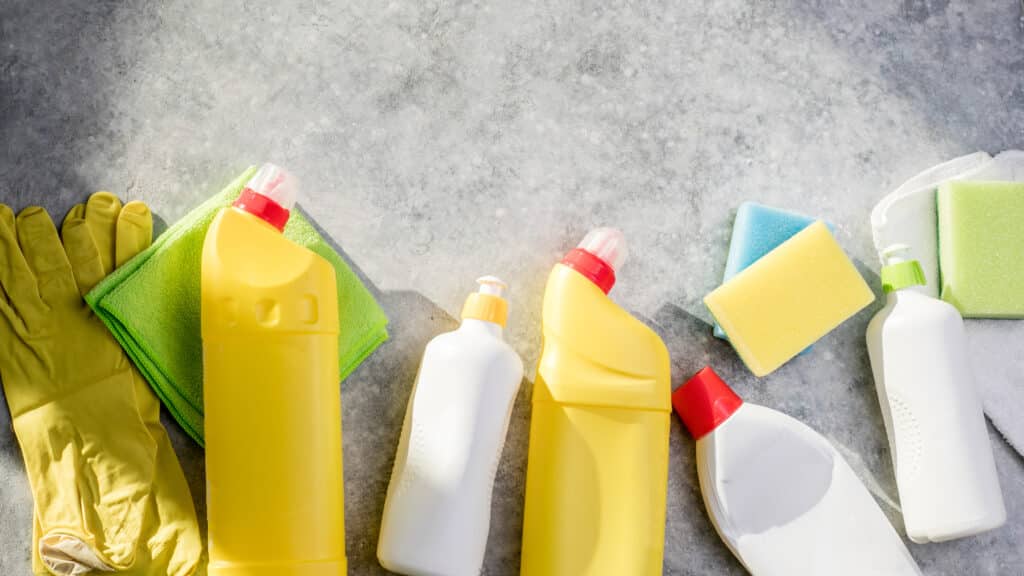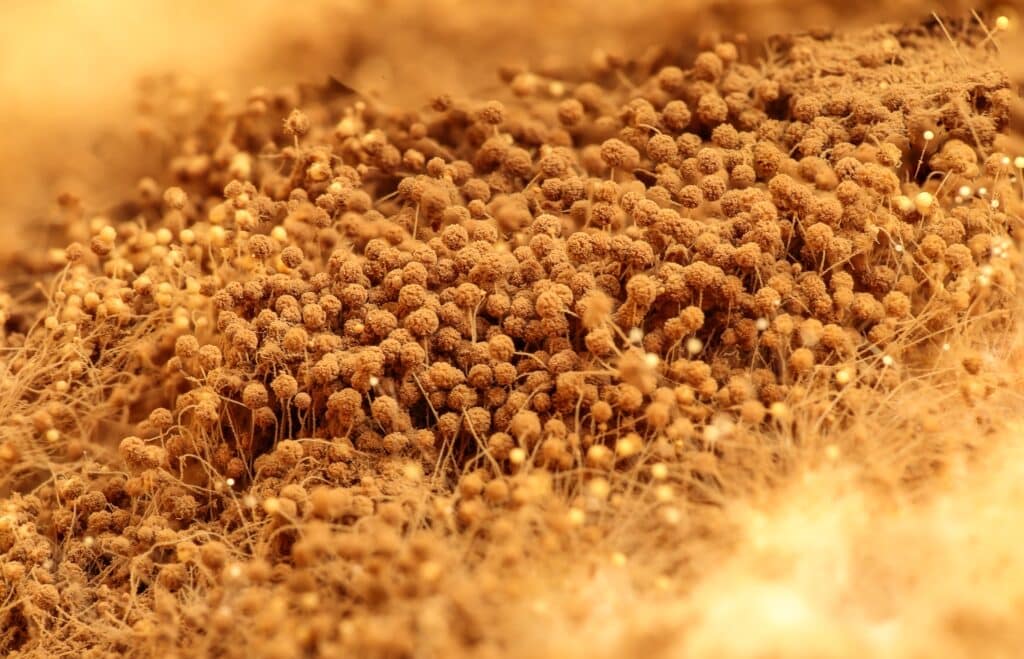When exposed to the slightest amount of moisture, the millions of microscopic mould spores lying dormant across your home will activate. These spores are far too small to be seen and can waft into the home carried on the wind from colonies of mould many miles away.
Moulds need one other ingredient to form a well-established colony, organic matter. Wood, paper, leather, wool, cotton and silk are made of organic materials and make good food sources for a mould population.
This is a considerable problem because the blackening growth can besmirch your personal belongings in very little time. Within a matter of weeks and under the right conditions a mold and mildew colony can work its way through an entire wardrobe leaving headaches and heartaches in its wake.
While keeping the atmosphere hostile to moulds and mildews is essential to preserving your clothing (and you will find a section dedicated to the subject of Mold and Mildew Prevention further in the article) it is important to know that these organic vermin can be eliminated if you catch the problem in time.
Tips for Removing Mold from Clothes

Successfully removing the moulds and mildews from your clothing requires a little experience in fabric care: Here are some helpful pointers to understand before beginning:
Act Fast– If you see that an area of your home or an item you had in storage is suddenly presenting signs of mould damage, this is an important sign. You can bet that there are other areas of the home that may be hosting a mould invasion. You will want to act as fast as you can. Do an inventory of your stored items and check carefully for signs of blackening along the edges and corners of storage containers, boxes, crates, trunks and cases.
The longer the moulds have a chance to build their establishments, the more damage can be done. Molds, mildews and moisture regularly turn solid oak trees into mulch. They can certainly eat through a fine leather jacket or pair of jeans if given time. Furthermore, as the mould damage gets bigger, the likelihood of fully restoring the colours and fabrics diminishes.
Health Concerns– Another important reason to have your storage cleaned from moulds and mildews is the health risks they can pose to you and those living with you. Spores can be inhaled and cause health conditions as well as excite allergies causing greater issues for those with asthma or other respiratory conditions. If these spores and mouldy clothes are worn, prolonged contact can cause skin conditions as well. This could be a minor itch or result in cuts and abrasions that get infected easily and don’t seem to heal.
Use Hot Water– While some organic fluids like blood, must be washed out with cold water, it is essential that hot water is used to neutralize the stains caused by molds. The water should be hot enough to also kill the spores and reduce the possibility of recurring issues, but also not so hot that the structural integrity of the fabrics is affected.
Multiple Cycles– when washing the effects of mold from your fabrics you will want to run your clothing through two cycles. After your clothing has been washed thoroughly, twice, you can then hang them out to dry. It is a good idea to use natural sunlight in the heat of the day for this task as the strong UV rays will finish the job effectively killing any remaining microbes. The sunlight also has elements that bleach the colour from the stain restoring the proper colouring to your clothing.
Choose your Chemical– There are a great variety of products and solutions that can be used to effectively remove mould from your clothing. You will want to choose your solution according to what suits your needs and clothing best.
While you can find special mould-killing detergents in the market, you can also use some other ingredients you may already have in your home. This article will illustrate the process for using bleach, borax and all-natural vinegar to effectively remove the last vestiges of moulds and mildews from your fabrics.
The Bleach Method

Bleach is an effective agent often applied to eliminate microbial menace. Additionally, bleach can assist in removing the stains left behind by the moulds. But, before you apply bleach to your clothing you will want to review their care labels to ensure that the colors and fabrics will not be affected by the harsh chemicals.
If you are not sure how your fabrics will react to the bleach, and there is no care label to provide instructions, you may want to choose one of the more delicate options described further in the article. You can also check the reactions by washing a small spot with your water and bleach mixture to see if the fabric withstands the bleach.
There are also many chlorinated detergents that can be used to eliminate moulds, lighten stains and restore colour. Check your local supermarkets for the varieties available to you.
Begin by placing the affected fabrics into your washing machine and filling the tank with the proper amount of water. You will not need to add any more bleach than you would normally use for the amount of water and colour of fabrics. Be sure to carefully read the instructions on the container to avoid adding too much bleach.
Allow your washing machine to go through the functions as normal. If you notice the colours of your fabrics are bleeding into the water, drain your washing machine and rinse the clothes well on a rinse cycle.
Alternatively, you can soak your fabrics in bleach to remove moulds and mildew.
A half cup of bleach to a gallon of water is a good rule of thumb, but you will need to follow the instructions on the bleach you are using.
Allow the clothes to soak for a few hours. Make sure to check them and rinse them out quickly if you notice their colours are beginning to run.
After they have soaked, you should continue the next step of the cleaning process by running your fabrics through a cycle in the washing machine.
The Borax Method

Borax is an all-natural cleaning agent that won’t damage your fabrics or emit any toxic fumes. There are laundry detergents that can be used that contain borax. Alternatively, you can purchase borax at many locations and add this to your regular wash cycles.
If you will be using your own borax, you will need to thoroughly dissolve the substance in hot water before adding it to your washing machine.
Place clothes in the washing machine and fill the tank to the appropriate levels.
Add the borax and hot water mixture to the water in the machine.
Allow the washing cycle to continue as normal.
Repeat
The White Vinegar method
Kinds of vinegar are effective at killing 82% of the moulds and mildew that can attack your clothing. Furthermore, vinegar will effectively remove the musty odour collected by clothing kept long in storage and exposed to spores.
Fill the washing machine with the clothing that needs to be washed. Add the correct amounts of detergents to the water as well.
You will want to add a cup and half of vinegar to a full washing machine.
Allow the washing cycle to continue as normal.
Repeat.
Alternatively, you can soak your clothing in a vinegar solution that will address the mould conditions.
Use a cup of white vinegar for a full bucket of water and allow your clothing to soak for an hour.
Remove from the bucket and wash the clothing in a washing machine for a full cycle.
If the musty smell is still in the clothing after you have washed it, you should repeat the process.
Mould and Mildew Prevention

While moulds and mildews can strike anywhere, those places in the tropics or with higher humidity levels are more prone to this problem. But, a little prevention goes a long way, following are a few ideas that can help you keep your clothing safe from moulds.
Wet clothing presents the optimal conditions for a mould colony. It is essential that your closets, storage rooms, chests and drawers are completely free of moisture. In addition to moisture-absorbing packaging materials, you should conduct a regular inventory to ascertain the mould threat in your home.
Clothing will get wet from simply being worn, if this is thrown into a heap for a week, you could expect a mould colony on your return. Always keep your clothes clean and dry. Hang up sweaty shirts, pants and socks to air out if needed before throwing them in the hamper. Hampers should be washed regularly to avoid mold growth and wet clothes should never be hung up with clean clothes.





